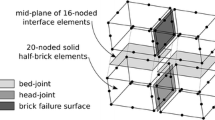Abstract
Computational modelling frameworks for masonry bridges range from highly simplified methods to complex nonlinear finite element or discrete elements. In majority of cases the macro level nonlinear finite element models1 and homogenisation techniques are adopted. Attention has also been given to assessment methodologies (discrete element method, rigid block spring method, lattice modelling, discontinuous deformation analysis, combined discrete/finite elements), which deal more directly with the discontinuous nature of structural masonry in a simplified micro modeling manner. These methods model an inherently discontinuous medium, but are also applied to problems where the transition from a continuum to discontinuum is important. Principal computational issue is the treatment of large number of distinct interacting domains, where the contact conditions are continuously updated and enforced as the solution progresses. Modelling of masonry arches requires a consideration of deformable multi-bodies and their contact nonlinearity, which is here realised in the context of the discontinuous deformation analysis, based on an assumed deformation field within distinct domains of arbitrary shapes with a rigorous imposition of contact constraints.
Similar content being viewed by others
Author information
Authors and Affiliations
Additional information
Dedicated to the memory of Prof. Mike Crisfield, for his cheerfulness and cooperation as a colleague and friend over many years.
Rights and permissions
About this article
Cite this article
Bićanić, N., Stirling, C. & Pearce, C. Discontinuous modelling of masonry bridges. Computational Mechanics 31, 60–68 (2003). https://doi.org/10.1007/s00466-002-0393-0
Issue Date:
DOI: https://doi.org/10.1007/s00466-002-0393-0




